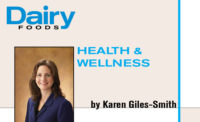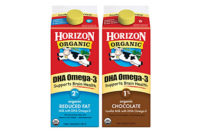In terms of influence in the market, baby boomers and millennials are running the show.
To which generation should the dairy industry cater? The best answer may be: both. Here’s why.
Boomers have more bucks per capita, but there are more millennials in the marketplace. By 2030, it’s estimated that millennials will number 78 million compared to 56 million boomers.
Many millennials are time-crunched multitaskers. To “get it done,” they demand convenience in eating: food when, where and how they want it. They’re super-snackers, often eating one meal daily plus several snacks — including ready-to-eat cereal, refrigerated lunches and yogurt. Millennials are a major driver of Greek (and overall) yogurt sales. They also love cheese and are willing to try different forms and flavors, as long as it is convenient to consume.
Boomers are busy, too, but strive for life balance. Eighty-one percent of their eating occasions take place at home. They view fresh and unpackaged foods with perishable ingredients as healthier and prefer scratch cooking, according to a 2014 report by The Hartman Group.
What these generations have in common is a desire for foods and beverages that foster health and wellness.
As noted in the 2011 study “Millennial Grocery Shoppers: Meet Your New Consumer” by Barkley, Kansas City, Mo., millennials view healthy eating as a lifestyle choice that includes knowing the origin of foods and their ingredients and eating all-natural, local or raw foods. In contrast, boomers are all about prevention, hoping for a healthy, active retirement.
“Boomers are trying to avoid the onset of illness such as the heart disease, diabetes and arthritis that their parents have,” said Shelley Balanko, senior vice president of business development, The Hartman Group, Bellevue, Wash.
“Everyone wants fresh, real, and less processed. One distinction is that boomers are more attuned than millennials to the functional benefits of foods and beverages,” she added. “Boomers are actively managing or preventing illness via their food and beverage choices. Boomers want quality of food for quality of life.”
Boomers prefer foods and beverages that are inherently good-for-you/naturally nutrient-rich, like dairy (and they’re willing to have a higher calorie and fat intake if it comes with nutrients). However, they aren’t against fortified foods — they’re actually more receptive to functional foods than other generations, explained Balanko.
“But only within categories or with ingredients that make sense, such as omega-3 fortified dairy products for heart health,” she said.
Of special note: boomers are more likely to accept fortification in beverages, such as smoothies, rather than food.
To endear itself to boomers, Balanko believes the dairy industry should leverage the inherent nutritional value of dairy and only then consider meaningful ways to add functional ingredients that will help prevent the health issues that concern boomers. Her advice: Think judiciously about functional benefits and choose to fortify beverages over foods.
Protein is one of the nutrients that’s top-of-mind for many consumers.
“Culturally, all cohorts are shifting toward more protein,” said Balanko. “And consumers are embracing dairy again because of its protein density.”
As they age, boomers may be more receptive to messages about protein and the prevention of age-related muscle loss, said Balanko.
Using health claims and food trends
Innova Market Insights says the top healthy aging-related claims for functional foods and drinks that are marketed to older consumers are:
- Digestive/gut health
- Energy/alertness
- Heart health
- Immune health
According to the International Dairy-Deli-Bakery Association, the leading global food trends to meet consumer needs are:
- Pleasure
- Health
- Convenience
- Wellbeing
- Ethics




